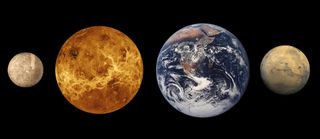How big is Earth?
Earth is the densest planet in the solar system.

Earth is the fifth largest planet in the solar system.
In his book "Pale Blue Dot: A Vision of the Human Future in Space" (Random House, 1994), astronomer and science communicator Carl Sagan once beautifully summed up how "big" Earth is for humanity.
"That's home. That's us," Sagan wrote. "On it, everyone you love, everyone you know, everyone you ever heard of, every human being who ever was, lived out their lives."
Though the sheer size of Earth in metaphorical terms is immeasurable to humanity, the planet's physical size can indeed be calculated.
Related: How old is Earth?
What is Earth's radius, diameter, circumference and shape?
Earth's widest point is the equator, which runs across the planet's center at zero degrees latitude. This is because Earth is not a perfect sphere; it has a prominence across its center called the equatorial bulge. According to NASA, Earth's radius at the equator is 3,963 miles (6,378 kilometers), while the radius at the poles is 3,950 miles (6,356 km).
Therefore, the diameter of Earth through its center is 7,926 miles (12,756 km). Again, because of the equatorial bulge, the planet's diameter is slightly smaller when measured from pole to pole, where it is about 7,900 miles (12,712 km).
The equatorial circumference of Earth is 24,901 miles (40,075 km). However, from the North Pole to the South Pole, the so-called meridional circumference is smaller, at 24,860 miles (40,008 km). That reveals that our planet is flattened at the poles, meaning its shape is an oblate spheroid.
FAQs about Earth's size
Who was the first person to determine Earth's size?
Throughout history, philosophers and scientists have debated the size and shape of Earth. Greek philosopher Aristotle is credited as the first person to have attempted to determine Earth's circumference, according to NOAA. He calculated the distance around the planet to be about 45,500 miles (73,225 km).
How do scientists measure Earth?
Today, scientists measure Earth by improving on a method developed by another Greek polymath, Eratosthenes, around 250 B.C. Eratosthenes used trigonometry to determine the distance between Aswan and Alexandria by measuring the position of the sun at the same time in both locations. He used this calculation and basic geometry, building on Aristotle's earlier ideas, to calculate the circumference of Earth to within 1% accuracy — staggering for over 2,000 years ago!
This practice formed the basis of geodesy, the science of measuring Earth's size and fundamental properties, such as its geometric shape, its orientation in space, and its gravity field.
Why is Earth bigger at the equator?
Earth bulges at the equator and is flattened at the poles as the result of force caused by the planet's rotation. Earth's rotational speed is faster at the equator than at the poles, as is the case for all rotating spheres. Interestingly, the equatorial bulge means that the gravitational pull of Earth is slightly weaker at the equator than at the poles, making the equator the ideal location for space launches.
What is Earth's volume, mass, density and surface area?
The volume of Earth is 260 billion cubic miles (1.086 trillion cubic kilometers), while its mass is 6.6 x 1021 tons (6 x 1021 metric tons), according to NASA. With these values known, and Earth's oddball shape accounted for, it is easy to calculate the density of Earth, which is around 5.5 grams per cubic centimeter.
The surface area of Earth is about 197 million square miles (510 million square kilometers). Around 57 million square miles (148 square km), or 29%, is taken up by land, while the remaining 140 million square miles (362 square km), or 71%, is covered by water.
The highest point on Earth's surface in terms of altitude above sea level is the top of Mount Everest, which peaks at 29,029 feet (8,848 meters). The farthest point from Earth's center is Mount Chimborazo, the summit of which is over 6,800 feet (2,073 m) farther from Earth's center than Mount Everest's summit is, according to the National Oceanic and Atmospheric Administration (NOAA).
How does Earth compare to the other planets in the solar system?

Earth is the fifth-largest planet in the solar system, behind Jupiter, Saturn, Uranus and Neptune.
With a diameter of 86,881 miles (139,822 km), Jupiter — the largest planet in the solar system — is 11 times wider than Earth. The gas giant has a volume of 343 trillion cubic miles (1,431 trillion cubic kilometers), meaning it would take around 1,320 Earths to fill the volume of Jupiter. According to NASA, if Earth were the size of a grape, Jupiter would be the size of a basketball.
The size difference between Earth and Jupiter is so pronounced that the Great Red Spot, a storm that has been raging in the gas giant's upper atmosphere for 200 years, is wider than our entire planet.
With a diameter of 30,599 miles (49,244 km), Neptune — the fourth largest planet in the solar system —is around four times as wide as Earth. It would take 57 Earths to fill the volume of Neptune. If Earth were the size of a nickel, Neptune would be the size of a baseball, according to NASA.
Although Earth is dwarfed by the outer planets, it is still the largest of the inner, rocky planets. Venus is the second largest rocky planet, followed by Mars and Mercury.
With a diameter of 3,032 miles (4,879 km), Mercury is around one-third the size of Earth. Earth and Mercury are the densest planets in the solar system, according to The Open University, with their densities similar to that of the iron-rich mineral hematite.
The reason for Earth's high density is its core, which has a diameter of around 7,000 miles (11,265 km) and is made of 80% iron and around 5% nickel and some lighter elements, such as carbon, oxygen, silicon, or sulfur. The density of Earth's inner solid core is as great as 12.2 grams per cubic centimeter, while the outer core has a density of around 13 grams per cubic centimeter, according to University College London.
Expert Q&A
We asked Simon Lock, a research fellow in the School of Earth Sciences at the University of Bristol who studies the dynamics of our planet, some questions about Earth's size and how it compares with those of other worlds.

Simon Lock is a research fellow in the School of Earth Sciences at the University of Bristol who studies the dynamics of our planet.
What is the exact size of Earth?
From the very center of the Earth to the surface [i.e., Earth's radius] is 6,378 km (3,963 miles), the same distance from Kampala [Uganda] to Kolkata [India] or London to Chicago.
How does Earth compare with other planets in terms of size?
Within our own solar system, Earth is the largest of the rocky, so-called terrestrial planets. The smallest, Mercury, is only 40% the radius of Earth. However, Jupiter is 11 times bigger than Earth and is the largest planet in our solar system, with its rocky core buried deep within an envelope of hydrogen and helium gas.
How common are Earth-like planets outside the solar system?
This is a hard question and depends on what you consider to be Earth-like. Planets that have a similar mass and composition to Earth are likely relatively common in other solar systems, but the ones we have found so far are typically too close to their stars to host liquid water oceans. We also don't know how many of those planets could have magnetic fields to protect their surfaces from damaging particles, or moons to stabilize their rotation. In short, there are lots of things that make Earth such a special planet, and we do not know enough about planets around other stars to confidently say how many planets like ours there are out there in the galaxy.
What does studying the dynamics of Earth entail?
There are many ways that scientists try and understand the dynamics of Earth. Some of my colleagues look at the chemistry of rocks on the surface of Earth or those brought to our planet in the form of meteorites to track the history of Earth and our solar system through time.
Others study the waves that come from earthquakes to image the inside of the planet, much like the way a CT scanner works, or measure how different materials behave at the high pressures and temperatures inside our planet.
I, myself, am a theorist, which means I try and use the laws of physics and chemistry to build models of the processes that have shaped, and continue to shape, our planet, using all my colleagues' work to constrain my calculations. Sometimes, this requires me to just sit down with a pen and paper and work through some math [and], at other times, to use some of the most powerful computers in the world. Most importantly, I spend a lot of time talking to other scientists, bouncing ideas off each other, and combining our knowledge to understand the workings of our dynamic planet.
Additional resources
How did Earth reach its current size? Khan Academy explains the formation of our planet.
There is a limit to how big planets can get before crossing into a category of objects called brown dwarfs. A NASA simulation replicates conditions across one of these "failed stars."
Want to feel really small? Tour the universe's largest black holes and compare them with distances in the solar system in this NASA simulation.
Bibliography
Densities of Solar System Planets, Open University, [accessed 10/20/23], [https://www.open.edu/openlearn/mod/oucontent/view.php?id=66947§ion=4.7#:~:text=Mercury%20and%20Earth%20are%20the,lower%20than%20that%20of%20water.]
Earth Fact Sheet, NASA, [accessed 10/20/23], [https://nssdc.gsfc.nasa.gov/planetary/factsheet/earthfact.html]
How large is Earth? CalTech Cool Cosmos, [accessed 10/20/23], [https://coolcosmos.ipac.caltech.edu/ask/57-How-large-is-Earth
The History of Geodesy, NOAA, [accessed 10/20/23], [https://oceanservice.noaa.gov/education/tutorial_geodesy/geo02_hist.html]
Join our Space Forums to keep talking space on the latest missions, night sky and more! And if you have a news tip, correction or comment, let us know at: community@space.com.
Get the Space.com Newsletter
Breaking space news, the latest updates on rocket launches, skywatching events and more!

Robert Lea is a science journalist in the U.K. whose articles have been published in Physics World, New Scientist, Astronomy Magazine, All About Space, Newsweek and ZME Science. He also writes about science communication for Elsevier and the European Journal of Physics. Rob holds a bachelor of science degree in physics and astronomy from the U.K.’s Open University. Follow him on Twitter @sciencef1rst.
